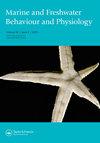Effects of severe hypoxia and glyceraldehyde-3-phosphate dehydrogenase (GAPDH) knock-down on its gene expression, activity, subcellular localization, and apoptosis in gills of the shrimp Penaeus vannamei
IF 1.1
4区 生物学
Q3 MARINE & FRESHWATER BIOLOGY
Marine and Freshwater Behaviour and Physiology
Pub Date : 2023-05-26
DOI:10.1080/10236244.2023.2216346
引用次数: 0
Abstract
ABSTRACT Penaeus vannamei, experiences hypoxia in its natural habitat and in aquaculture. Under hypoxia, cells enhance anaerobic energy production through glycolysis dependent on the up-regulation of glycolytic enzymes including glyceraldehyde-3-phosphate dehydrogenase (GAPDH) in gills. In vertebrates, GAPDH translocates into the nucleus and displays “moonlighting” functions including apoptosis. These alternative localizations and functions have not been described in crustaceans. We examined the effect of severe hypoxia and GAPDH silencing by RNA interference (RNAi) on its mRNA expression localization and glycolytic activity in P. vannamei gills. Expression and cytosolic activity were up-regulated only in hypoxia-exposed shrimp, but not in hypoxia-silenced specimens. GAPDH was immunodetected in cytosol and nucleus regardless of oxygen conditions. Hypoxia and RNAi decreased activity in cytosol and nucleus without affecting protein abundance, which suggests that nuclear GAPDH may have non-glycolytic functions. Moreover, Caspase-3 (Casp-3) expression increased with GAPDH silencing, suggesting alternative roles for GAPDH in apoptosis evasion.严重缺氧和甘油醛-3-磷酸脱氢酶(GAPDH)敲低对凡纳滨对虾鳃中GAPDH基因表达、活性、亚细胞定位和凋亡的影响
凡纳滨对虾(Penaeus vannamei)在其自然栖息地和水产养殖中都会经历缺氧。在缺氧条件下,细胞通过糖酵解提高厌氧能量的产生依赖于糖酵解酶的上调,包括鳃中的甘油醛-3-磷酸脱氢酶(GAPDH)。在脊椎动物中,GAPDH易位到细胞核中并表现出包括细胞凋亡在内的“兼职”功能。这些可选择的定位和功能尚未在甲壳类动物中描述。我们研究了严重缺氧和RNA干扰(RNAi)沉默GAPDH对凡纳滨对虾鳃中GAPDH mRNA表达定位和糖酵解活性的影响。表达和胞浆活性仅在缺氧暴露的虾中上调,而在缺氧沉默的虾中没有上调。无论氧条件如何,细胞质和细胞核均免疫检测到GAPDH。缺氧和RNAi降低细胞质和细胞核的活性,但不影响蛋白质丰度,这表明核GAPDH可能具有非糖酵解功能。此外,Caspase-3 (Casp-3)的表达随着GAPDH的沉默而增加,提示GAPDH在细胞凋亡逃避中的其他作用。
本文章由计算机程序翻译,如有差异,请以英文原文为准。
求助全文
约1分钟内获得全文
求助全文
来源期刊

Marine and Freshwater Behaviour and Physiology
生物-海洋与淡水生物学
CiteScore
2.10
自引率
0.00%
发文量
9
审稿时长
>12 weeks
期刊介绍:
Marine and Freshwater Behaviour and Physiology is devoted to the publication of papers covering field and laboratory research into all aspects of the behaviour and physiology of all marine and freshwater animals within the contexts of ecology, evolution and conservation.
As the living resources of the world’s oceans, rivers and lakes are attracting increasing attention as food sources for humans and for their role in global ecology, the journal will also publish the results of research in the areas of fisheries biology and technology where the behaviour and physiology described have clear links to the contexts mentioned above.
The journal will accept for publication Research Articles, Reviews, Rapid Communications and Technical Notes (see Instructions for authors for details). In addition, Editorials, Opinions and Book Reviews (invited and suggested) will also occasionally be published. Suggestions to the Editor-In-Chief for Special Issues are encouraged and will be considered on an ad hoc basis.
With the goal of supporting early career researchers, the journal particularly invites submissions from graduate students and post-doctoral researchers. In addition to recognising the time constraints and logistical limitations their research often faces, and their particular need for a prompt review process, accepted articles by such researchers will be given prominence within the journal (see Instructions for authors for details).
 求助内容:
求助内容: 应助结果提醒方式:
应助结果提醒方式:


